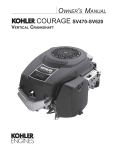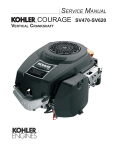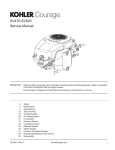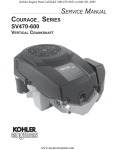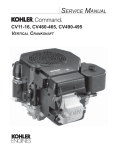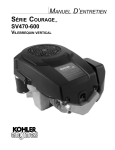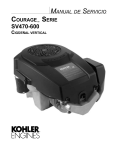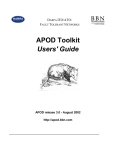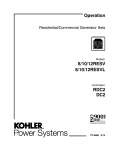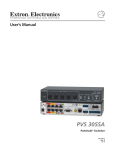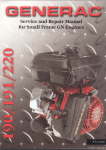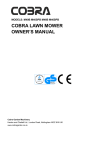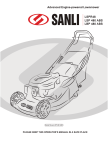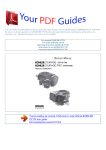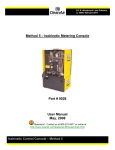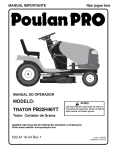Download Operating instructions KOHLER SV600
Transcript
You can read the recommendations in the user guide, the technical guide or the installation guide for KOHLER SV600. You'll find the answers to all your questions on the KOHLER SV600 in the user manual (information, specifications, safety advice, size, accessories, etc.). Detailed instructions for use are in the User's Guide. User manual KOHLER SV600 User guide KOHLER SV600 Operating instructions KOHLER SV600 Instructions for use KOHLER SV600 Instruction manual KOHLER SV600 You're reading an excerpt. Click here to read official KOHLER SV600 user guide http://yourpdfguides.com/dref/3373953 Manual abstract: .......... ..... ..... .......... .......... ..... ..... .......... .......... .. Section 5. Fuel System and Governor.. ..... .......... .......... ..... ..... .......... .......... ..... ..... .......... ........ Section 6. Lubrication System . ..... ..... .......... .......... ..... ..... .......... .......... ..... ..... .......... .......... ..... . Section 7. Electrical System and Components ... .......... .......... ..... ..... .......... .......... ..... ..... ....... Section 8. Disassembly.. .......... ..... ..... .......... .......... ..... ..... .......... .......... ..... ..... .......... .......... ..... .. Section 9. Inspection and Reconditioning .. .......... .......... ..... ..... .......... .......... ..... ..... .......... ...... Section 10. Reassembly... ..... ..... .......... .......... ..... ..... .......... .......... ..... ..... .......... .......... ..... ..... ..... Section 1 Safety and General Information Section 1 Safety and General Information Safety Precautions To ensure safe operation please read the following statements and understand their meaning. Also refer to your equipment manufacturer's manual for other important safety information. This manual contains safety precautions which are explained below. Please read carefully. WARNING Warning is used to indicate the presence of a hazard that can cause severe personal injury, death, or substantial property damage if the warning is ignored. CAUTION Caution is used to indicate the presence of a hazard that will or can cause minor personal injury or property damage if the caution is ignored. NOTE Note is used to notify people of installation, operation, or maintenance information that is important but not hazard-related. For Your Safety! These precautions should be followed at all times. Failure to follow these precautions could result in injury to yourself and others. 1 WARNING WARNING WARNING Accidental Starts can cause severe injury or death. Disconnect and ground spark plug leads before servicing. Rotating Parts can cause severe injury. Stay away while engine is in operation. Hot Parts can cause severe burns. Do not touch engine while operating Accidental Starts! Disabling engine. Accidental starting can cause severe injury or death. Before working on the engine or equipment, disable the engine as follows: 1) Disconnect the spark plug lead(s). 2) Disconnect negative (-) Rotating Parts! Keep hands, feet, hair, and clothing away from all moving parts to prevent injury. Never operate the engine with covers, shrouds, or guards removed. Hot Parts! Engine components can get extremely hot from operation. To prevent severe burns, do not touch these areas while the engine is running, or immediately the engine with heat shields or guards removed. 1.1 Section 1 Safety and General Information WARNING WARNING WARNING and severe burns. engine is hot or running. Carbon Monoxide can cause severe nausea, fainting or death. Avoid inhaling exhaust fumes, and never run the engine in a closed severe acid burns. ventilated area. Keep sources of ignition away. Explosive Fuel! its vapors can explode if ignited. Store gasoline only in approved containers, in well ventilated, unoccupied Lethal Exhaust Gases! Engine exhaust gases contain poisonous carbon monoxide. Carbon monoxide is odorless, colorless, and can cause death if inhaled. Avoid inhaling exhaust fumes, and never run the area. Explosive Gas! gas while being charged. To prevent a in well ventilated areas. Keep engine is hot or running, since spilled fuel could ignite if it comes in contact with hot parts or sparks from ignition. Do not start the engine near spilled fuel. Never use gasoline as a cleaning agent. of children. Remove all jewelry when WARNING Before disconnecting the negative (-) ground cable, make sure all switches are OFF. If ON, a spark will occur at the ground cable terminal which could cause an explosion if hydrogen gas or gasoline vapors are present. CAUTION Cleaning Solvents can cause severe injury or death. Use only in well ventilated areas away from ignition sources. Electrical Shock can cause injury. Do not touch wires while engine is running. Flammable Solvents! Carburetor cleaners and solvents are away from the area. Follow the cleaner manufacturer's warnings and instructions on its proper and safe use. Never use gasoline as a cleaning agent. Electrical Shock! Never touch electrical wires or components while the engine is running. They can be sources of electrical shock. 1. 2 Section 1 Safety and General Information When ordering parts, or in any communication involving an engine, always give the Model, of the engine. 1 A. Model No. Courage Vertical Shaft Engine Numerical Designation SV 540 S Version Code S = Electric Start B. Spec. No. Engine Model Model SV470 SV480 SV530 SV540 SV590 SV600 SV610 SV620 SV540-0001 First spec written in this model series C. Serial No. Year Manufactured Code Code Year 32 2002 33 2003 34 2004 35 2005 36 2006 37 2007 38 2008 3205810334 Factory Code 1.3 Section 1 Safety and General Information Oil Recommendations Using the proper type and weight of oil in the crankcase is extremely important, as is checking oil correct oil or using dirty oil causes premature engine wear and failure. Oil Type Use high-quality detergent oil of . Select the viscosity based on the air temperature at the time of operation as shown below. RECOMMENDED SAE VISCOSITY GRADES 10W-30 Fuel Recommendations WARNING: Explosive Fuel! if ignited. Store gasoline only in approved containers, in well ventilated, unoccupied buildings, away from sparks or running, since spilled fuel could ignite if it comes in contact with hot parts or sparks from ignition. Do not start the engine near spilled fuel. Never use gasoline as a cleaning agent. General Recommendations Purchase gasoline in small quantities and store in clean, approved containers. A container with a recommended. Such a container is easier to handle and helps eliminate spillage during refueling. 100 40 ** 5W-20, 5W-30 * Kohler 10W-30 °F -20 °C -30 -20 0 -10 20 32 0 40 10 60 20 80 30 TEMPERATURE RANGE EXPECTED BEFORE NEXT OIL CHANGE * Use of synthetic oil having 5W-20 or 5W-30 rating is acceptable, up to 4°C (40°F) ** Synthetic oils will provide better starting in extreme cold below -23°C (-10°F) season, to minimize gum deposits in your fuel system and to ensure easy starting. Do not add oil to the gasoline. NOTE: Using other than service class SJ or higher oil or extending oil change intervals longer than recommended can cause engine damage. NOTE: Synthetic oils meeting the listed performed at the recommended intervals. However to allow piston rings to properly seat, a new or rebuilt engine should be operated for at least 50 hours using standard petroleum based oil before switching to synthetic oil. to expand. Fuel Type gasoline with a pump sticker octane rating of 87 or should be 90 octane minimum. Unleaded gasoline is recommended, as it leaves less be used in areas where unleaded is not available and exhaust emissions are not regulated. Be aware however, that the cylinder head will require more frequent service. Gasoline/Alcohol Blends API SE RVIC gasoline by volume) is approved as a fuel for Kohler and E85 are not to be used and not approved. Any failures resulting from use of these fuels will not be warranted. Gasoline/Ether Blends Methyl Tertiary Butyl Ether (MTBE) and unleaded volume) are approved as a fuel for Kohler engines. Other gasoline/ether blends are not approved. SAE 10W-30 Figure 1-3. You're reading an excerpt. Click here to read official KOHLER SV600 user guide http://yourpdfguides.com/dref/3373953 Oil Container Logo. E SJ 1. 4 Section 1 Safety and General Information Periodic Maintenance WARNING: Accidental Starts! Disabling engine. Accidental starting can cause severe injury or death. Before working on the engine or equipment, 1 Maintenance Schedule These required maintenance procedures should be performed at the frequency stated in the table. They should also be included as part of any seasonal tune-up. Frequency Daily or Before Starting Engine Every 2 Months or 25 Hours Maintenance Required · · · · · Check oil level. Check air cleaner for dirty¹, loose, or damaged parts. Check air intake and cooling areas, clean as necessary¹. Service precleaner element¹ (if equipped). Service air cleaner element¹ (if not equipped with precleaner). Annually or Every 100 Hours · Every 2 Years or 200 Hours Every 200 Hours Every 500 Hours · · · temperatures). Check that all fasteners are in place and components are properly secured. Check spark plug condition and gap. Have bendix starter drive serviced². Have valve lash checked/adjusted . ¹Perform these maintenance procedures more frequently under extremely dusty, dirty conditions. ²Have a Kohler Engine Service Dealer perform this service. Storage more, use the following storage procedure: To empty the system, run the engine until the tank and system are empty. still warm from operation. See Change Oil and the spark plug. The spark plug is most accessible when the blower housing is removed for cleaning. Add one tablespoon of engine oil into the spark 3. The fuel system must be completely emptied, or the gasoline must be treated with a stabilizer use a stabilizer, follow the manufacturer's recommendations, and add the correct amount the plug lead. Crank the engine two or three revolutions. Connect the plug lead. previously, and torque the blower housing screws to . carburetor. 1.5 Section 1 Safety and General Information Dimensions in millimeters. Inch equivalents shown in (). VALVE COVER VIEW Figure 1-4. Typical Engine Dimensions. 1.6 Section 1 Safety and General Information ........ .......... ..... ..... .......... .......... ..... ..... .......... .......... ..... ..... .......... .......... . .... ..... .......... .......... ..... ..... .......... .......... ..... ..... .......... .......... ..... ..... .......... .......... ..... ..... .......... .......... ..... ..... .......... .......... ..... ..... .......... .......... ..... .... . .......... .......... ..... ..... .......... .......... ..... ..... .......... .......... ..... ..... .......... ......... . ..... ..... .......... .......... ..... ..... .......... .......... ..... ..... .......... .......... ..... ..... ........ .. .......... ..... ..... .......... .......... ..... ..... .......... .......... ..... ..... .......... .......... ..... ... .. .......... .......... ..... ..... .......... .......... ..... ..... .......... .......... ..... ..... .......... ........ .. ..... ..... .......... .......... ..... ..... .......... .......... ..... ..... .......... .......... ..... ..... ........ Bore .. .......... ..... ..... .......... .......... ..... ..... ......... . .......... ..... ..... .......... .......... ..... ..... .......... .......... . 89 mm (3.50 in.) .. ..... .......... .......... ..... ..... .......... .......... ..... ..... ..... Stroke..... .......... ..... ..... .......... .......... ..... ..... .......... .......... ..... ..... .......... .......... ..... ..... ... Displacement ....... .......... ..... ..... .......... .......... ..... ..... .... ...... .......... ..... ..... .......... .......... ..... ..... .......... ...... .... ..... ..... .......... .......... ..... ..... .......... .......... ..... ... 1 .. .......... .......... ..... ..... .......... .......... ..... ..... .......... .......... ..... ..... .......... .......... ..... ..... .......... .......... .. Dry Weight... ..... .......... .......... ..... ..... .......... .......... ..... ..... .......... .......... ..... ..... .......... . 35.8 kg (79 lb.) ....... ..... ..... .......... .......... ..... ..... .......... .......... ..... ..... ........ .. .......... ... Air Cleaner Base .. ..... .......... .......... ..... ..... .......... .......... ..... ..... .......... ....... ... ..... ..... ....... Blower Housing and Sheet Metal ... .......... ..... ..... .......... .......... ..... ..... .......... ... Cam Lever ....... ..... ..... .......... .......... ..... ..... ....... Cam Gears End Play ... .......... ..... ..... .......... .......... ..... ..... .......... .......... ..... ..... .......... .......... ..... .. ... .......... .......... ..... ..... .......... .......... ..... ..... .......... .......... . .... ..... .......... .......... ..... ..... .......... Carburetor .......... ..... ..... .......... .......... ..... ..... .......... ..... to assembly, EXCEPT for air clean..... ..... ..... .......... .......... ..... ..... .......... .......... ..... ..... .......... .......... .... . ..... .......... .......... ..... ..... .......... .......... ..... ..... .......... .......... ... New .. ..... .......... .......... ..... ..... .......... .......... ..... ..... .......... .......... ..... ..... .......... .. ........ ..... ..... .......... .......... ..... ..... .......... .......... ..... ..... .......... . New......... ..... ..... .......... .......... ..... ..... .......... .......... ..... ..... .......... .......... ..... ..... . ......... .......... ..... ..... .......... .......... ..... ..... .......... .......... ..... ..... New.......... .......... ..... ..... .......... .......... ..... ..... .......... .......... ..... ..... .......... .......... ..... ..... .......... .......... ..... ..... .......... .......... ..... ..... .......... ......... New. ..... ..... .......... .......... ..... ..... .......... .......... ..... ..... .......... .......... ..... ..... ......... . .......... ..... ..... .......... .......... ..... ..... .......... .......... ..... ..... ........ Balance Weight Screw Torque .. .......... ..... ..... .......... .......... ..... ..... .......... .......... . 1.9 Section 1 Safety and General Information Cylinder Bore New ... ..... .......... .......... ..... ..... .......... .......... ..... ..... .......... .... ...... ..... ..... .......... .......... ..... ..... .......... .......... ..... ..... ...... .... .......... ..... ..... .......... .......... ..... ..... .......... .......... ..... ..... ......... . .......... ..... ..... .......... .......... ..... ..... .......... ...... .... ..... ..... .......... .......... ..... ..... .......... .......... ..... ..... ........ .. .......... ..... ..... .......... .......... ..... ..... .......... .......... ..... ..... .......... .......... ..... ..... .......... .......... ..... ..... .......... .......... ..... ..... ... 89.073 mm (3.507 in.) .... .......... ..... ..... .......... .......... ..... ..... .......... ... Max. Taper ...... ..... ..... .......... .......... ..... ..... .......... .......... ..... ..... .......... .......... .. ... ..... .......... .......... ..... ..... .......... .......... ..... ..... .......... ...... Cylinder Head .... ..... ..... .......... .. ........ ..... ..... .......... .......... ..... ..... .......... .......... ..... ..... .......... 0.8 mm (0.003 in.) ....... ..... ..... .......... .......... ..... ..... .......... .......... .... . ..... .......... .......... ..... ..... .......... .......... 5.5 N·m (50 in. lb.) Electric Starter Thru Bolt Torque .. ..... .......... .......... ..... ..... .......... .......... ..... ..... .......... .......... ..... ... 3.3-3. 9 N·m (30-35 in. lb.) Mounting Nut Torque ........ .......... ..... ..... .......... .......... ..... ..... .......... .......... ..... ... .. .......... .......... ..... ..... .......... ....... ... ..... ..... .......... .......... ..... ..... . Fan/Flywheel ......... .......... ..... ..... .......... .......... ..... ... .. .......... .......... ..... ..... .......... .......... ..... Governor ..... .......... .......... .. New... ..... .......... .......... ..... ..... .......... .......... ..... ..... .......... .......... ..... ..... .......... .. ........ ..... ..... .......... .......... ..... ..... .......... .......... ..... ..... .......... . ......... ..... ..... .. New ........ .......... ..... ..... .......... .......... ..... ..... .......... .......... ..... ..... .......... .......... . .... ..... .......... .......... ..... ..... .......... .......... ..... ..... .......... ......... Ignition Spark Plug Type (Champion® or Equivalent) . ..... ..... .......... .......... ..... ..... ...... Spark Plug Gap.... .......... ..... ..... .......... .......... ..... ..... .......... .......... ..... ..... .......... .... 1.10 Section 1 Safety and General Information Ignition (Continued) Spark Plug Torque..... ..... ..... .......... .......... ..... ..... .......... .......... ..... ..... .......... ........ .. ..... ..... .......... .......... ..... ..... .......... .......... ..... ..... ........ .. .......... ..... ..... .......... .......... ..... ..... .......... ..... 1 ..... ..... ..... .......... .......... ..... ..... .......... .......... ..... Oil Filter ..... .......... .......... ..... ..... .......... .......... ..... ..... .......... .......... ..... ..... . Oil Filter Pad Pipe Plug ......... .......... ..... ..... .......... .......... ..... ..... .......... .......... ..... ..... . Oil Pump Mounting Screw Torque......... .......... ..... ..... .......... .......... ..... ..... .. Pump Gears-to-Crankcase Side Clearance........ .......... ..... ..... .......... .......... .... Oil SentryTM Pressure Switch Torque. ..... .......... .......... ..... ..... .......... .......... ..... ..... .......... ........ Piston, Piston Rings, and Piston Pin New.. ..... ..... .......... .......... ..... ..... .......... .......... ..... ..... .......... .......... ..... ..... ........ .. .......... ..... ..... .......... .......... ..... ..... .......... .......... ..... ..... ....... Piston Pin O.D. New. .......... ..... ..... .......... .......... ..... ..... .......... .......... ..... ..... .......... .......... ..... .... . .......... .......... ..... ..... .......... .......... ..... ..... .......... .......... ..... ... .. .......... .......... ..... ..... ..... ..... .......... ..... ..... ...... New Bore .... .......... ..... ..... .......... .......... ..... ..... .......... .......... ..... ..... .......... ...... .... ..... ..... .......... .......... ..... ..... .......... .......... ..... ..... .......... .......... Used Bore (max.).... ..... .......... .......... ..... ..... .......... .......... ..... ..... .......... ......... 0. 77 mm (0.030 in.) New ... ..... .......... .......... ..... ..... .......... .......... ..... ..... .......... .......... ..... ..... .......... .......... ..... ..... .......... .......... ..... ..... .......... .......... ..... ..... ....... New ... .......... ..... ..... .......... .......... ..... ..... .......... .......... ..... ..... .......... .......... ..... ..... .......... .......... ..... ..... .......... .......... ..... ..... .......... .......... .. 1.11 Section 1 Safety and General Information Piston, Piston Rings, and Piston Pin (Continued) New .. ..... .......... .......... ..... ..... .......... .......... ..... ..... .......... .......... ..... ..... .......... . ......... ..... ..... .......... .......... ..... ..... .......... .......... ..... ..... ........ New .. .......... ..... ..... .......... .......... ..... ..... .......... .......... ..... ..... .......... .......... ..... . .... .......... .......... ..... ..... .......... .......... ..... ..... .......... .......... ... .. ..... .......... .......... ..... ..... .......... .......... ..... ..... . ......... .......... ..... ..... .......... .......... ..... . 0.0880 mm (0.0035 in.) Mounting Screw Torque. .......... .......... ..... ..... .......... .......... ..... ..... .......... .......... .. Speed Control ... ..... .......... .......... ..... ..... Stator Stator Mounting Screw Torque .......... .......... ..... ..... .......... .......... ..... ..... .......... . Throttle/Choke Controls ......... ..... ..... .......... .......... ..... ..... .... Valve Cover ...... .......... ..... ..... .......... .......... ..... ..... .......... ......... Valves and Valve Lifters 3 . ..... ..... .......... .......... ..... ..... .......... .......... ..... ..... .......... .......... .. 3 ... ..... .......... .......... ..... ..... .......... .......... ..... ..... .......... .......... .. ... ..... .......... .......... ..... ..... .......... .......... ..... ..... ......... 8. 9 mm (0.350 in.) ........ ..... ..... .......... .......... ..... ..... .......... .......... ..... . 8.9 mm (0.350 in.) . .......... .......... ..... ..... .......... .......... ..... ..... .......... ........ .. ..... ..... .......... ......... . ..... ..... .......... ....... New... ..... ..... .......... .......... ..... ..... .......... .......... ..... ..... .......... .......... ..... ..... ....... ... .......... ..... ..... .......... .......... ..... ..... .......... .......... ..... ..... ...... 3 1.12 Section 1 Safety and General Information Valves and Valve Lifters (Continued) New... .......... ..... ..... .......... .......... ..... ..... .......... .......... ..... ..... .......... .......... ..... .. 1 New... .......... .......... ..... ..... .......... .......... ..... ..... .......... .......... ..... ..... .......... ....... ... ..... ..... .......... .......... ..... ..... .......... .......... ..... ..... .......... ...... New.... ..... ..... .......... .......... ..... ..... .......... .......... ..... ..... .......... .......... ..... ..... ...... General Torque Values Metric Fastener Torque Recommendations for Standard Applications Tightening Torque: N·m (in. lb.) + or - 10% Property Class 4.8 Size M4 M5 M8 5. 8 8.8 10.9 12.9 Noncritical Fasteners Into Aluminum Tightening Torque: N·m (ft. lb.) + or - 10% Property Class 4.8 M10 M12 M14 5.8 8.8 10.9 12. 9 Noncritical Fasteners Into Aluminum Oil Drain Plugs Tightening Torque: N·m (English) Size 1/8" NPT 1/4" 3/8" 1/2" 3/4" X-708-1 Into Cast Iron Into Aluminum Torque Conversions in. lb. = N·m x 8.85 1.13 Section 2 Tools & Aids Section 2 Tools & Aids 2 Separate Tool Suppliers: Kohler Tools Contact your source SE Tools Tools Description Balance Gear Timing Tool (K & M Series) Source/Part No. Pressure Tester Noid Light 2.1 Section 2 Tools & Aids Tools (Continued) Description Source/Part No. To remove and reinstall drive retaining rings and brushes. Individual Component Available Starter Brush Holding Tool (Solenoid Shift) Tachometer (Digital Inductive) For checking operating speed (RPM) of an engine. Vacuum/Pressure Tester Alternative to a water manometer. Valve Guide Reamer (K & M Series) For sizing valve guides after installation. SE Tools KLR-82411 SE Tools KLR-82416 Design Technology Inc. DTI-110 Kohler 25 761 22-S SE Tools KLR-11843 2.2 Section 2 Tools & Aids Aids Description Source/Part No. 2 Loctite® Ultra Copper 2.3 Section 2 Tools & Aids Special Tools You Can Make Flywheel Holding Tool . Figure 2-2. Rocker Arm/Crankshaft Tool. Figure 2-1. Flywheel Holding Tool. Rocker Arm/Crankshaft Tool 2.4 Section 3 Troubleshooting Section 3 Troubleshooting 3 Troubleshooting Guide When troubles occur, be sure to check the simple considered. For example, a starting problem could be Engine Will Not Crank below. Use these to help locate the possible cause(s). Engine Cranks But Will Not Start restricted. 7. Seized internal engine components. 5. Spark plug lead disconnected. Engine Runs But Misses 4. Spark plug lead boot loose on plug. 10. Choke not closing. ground. Engine Starts But Does Not Keep Running Engine Will Not Idle 4. Loose wires or connections that short the kill Engine Starts Hard 7. Low compression. problem. 7. Low compression. 9. Weak spark. 3.1 Section 3 Troubleshooting Engine Overheats shrouds clogged. Engine Knocks 4. Internal wear or damage. Engine Loses Power maintenance. 8. Low compression. 9. Exhaust restriction. odor. Engine Uses Excessive Amount of Oil 3. Worn or broken piston rings. used, the oil was not changed at the recommended Oil Leaks from Oil Seals, Gaskets 2. Worn or broken piston rings. 4. Restricted exhaust. NOTE: It is good practice to drain oil at a location Cleaning the Engine External Engine Inspection when it is disassembled. engine parts. When such a cleaner is used, follow the manufacturer's instructions and safety precautions carefully. 3.2 Section 3 Troubleshooting the engine is reassembled and placed into operation. 2. Start the engine and run at no-load high idle speed (3200 to 3750 RPM). tube. Basic Engine Tests Crankcase Vacuum Test crankcase when the engine is operating. Pressure 10.2 cm (4 in.) 3 below. 4. Close the pinch clamp before stopping the engine. You're reading an excerpt. Click here to read official KOHLER SV600 user guide http://yourpdfguides.com/dref/3373953 testers. 1. Insert the stopper as in step 1. Be sure the pinch clamp is installed on the hose and use the tapered adapters to connect stopper. Be sure the gauge needle is at "0". manometer is at the "0" line. Make sure the pinch clamp is closed. Incorrect Vacuum in Crankcase Possible Cause Solution reassemble, and recheck pressure. 2. Replace all worn or damaged seals and gaskets. 4. Restricted exhaust. 3.3 Section 3 Troubleshooting Compression Test These engines are equipped with an automatic a shoulder bolt through the slot and thread it into leakdown test described below. Cylinder Leakdown Test TDC in either direction. 4. Install the adapter into the spark plug hole, but 5. Connect an adequate air source (80-100 psi) to the tester. Leakdown Test Instructions 6. Turn the regulator knob in the increase (clockwise) direction until the gauge needle is in scale. 7. Connect the tester quickdisconnect to the will need to hold the engine in this position while testing. The holding tool supplied with escaping air at the carburetor inlet, exhaust Leakdown Test Results . ..... .......... .......... ..... ..... .......... .. ........ ..... ..... .......... .......... ..... ..... ...... .... .......... ..... ..... .......... .......... ..... ..... ......... Gauge reading in low (green) zone . .......... ..... ..... .......... .......... ..... ..... .. ........ .......... ..... ..... .......... ...Engine is still usable, but there is some wear Gauge reading in high (red) zone....... ..... ..... .......... .......... ..... ..... ......... Engine should be reconditioned or replaced. 3.4 Section 4 Air Cleaner and Air Intake System Section 4 Air Cleaner and Air Intake System Air Cleaner These engines are equipped with a replaceable, high density, paper air cleaner element. Some engines also have an oiled, foam precleaner, located in the outer air cleaner cover. See Figure 4-1. Intake air is drawn in through the upper opening from the blower housing, passes through the precleaner (if so equipped), the paper element and then into the carburetor. The outer air cleaner cover is secured by two knobs, and removed by turning the knobs counterclockwise. 4 Air Cleaner Base Air Cleaner Element Air Cleaner Cover Optional Foam Precleaner Air Cleaner Cover Knobs Figure 4-1. Air Cleaner Assembly - Exploded View. Check the air cleaner daily or before starting the engine. Check for and correct any buildup of dirt and debris, and loose or damaged components. NOTE: Operating the engine with loose or damaged air cleaner components could premature wear and failure. 2. Remove the precleaner. Precleaner Service If so equipped, wash and oil the precleaner every two months or every 25 hours under extremely dusty or dirty conditions). 1. Loosen the air cleaner cover knobs and remove the cover. 4.1 Section 4 Air Cleaner and Air Intake System 3. Wash the precleaner in warm water with detergent. Rinse the precleaner thoroughly until all traces of detergent are eliminated. Squeeze out excess water (do not wring). Allow the precleaner to air dry. 4. Saturate the precleaner with new engine oil. Squeeze out all excess oil. 5. Reinstall the precleaner into the outer cover. 6. Install the air cleaner cover and secure with the two knobs. 7. When precleaner replacement is necessary, order Kohler Part No. 20 083 03-S. Paper Element Service Check the paper element every two months or every 25 hours dusty or dirty conditions). Clean or replace the element as necessary. Replace the air cleaner element annually or every 100 hours. 1. Remove the air cleaner cover and the precleaner (if so equipped), service as required. 2. Remove the air cleaner element with the integral rubber seal. 3. Gently tap the pleated side of the paper element to dislodge dirt. Do not wash the paper element or use pressurized air, as this will damage the element. Replace a dirty, bent, or damaged element with a genuine Kohler element. Handle new elements carefully; do not use if the rubber seal is damaged. 4. Clean all air cleaner components of any accumulated dirt or foreign material. Prevent any dirt from entering the throat of the carburetor. 5. Install the air cleaner element with the pleated side out and seat the rubber seal onto the edges of the air cleaner base. 6. Reinstall the precleaner (if so equipped), into the upper section of the air cleaner cover. Make sure the hole in the precleaner is aligned with the upper mounting knob. See Figure 4-1. 7. Reinstall the air cleaner cover and secure with the two knobs. Figure 4-2. Bushings in Air Cleaner Base. Breather Hose Make sure the hose is not cracked or and valve cover. NOTE: Damaged, worn, or loose air cleaner engine causing premature wear and failure. Tighten or replace all loose or damaged components. 8. When element replacement is necessary, order Kohler Part No. 20 083 02-S. Inspect Air Cleaner Components Whenever the air cleaner cover is removed, or the paper element or precleaner is serviced, check the following areas/components: Outer Air Cleaner Cover - Make sure the air cleaner cover is in good condition, not cracked, damaged, or ability of the air cleaner element. Air Cleaner Base - Make sure the base is properly secured and not cracked or damaged. Since the air cleaner base and carburetor are secured to the intake port with common hardware, it is extremely important that the fasteners securing these components are tight at all times. The air cleaner base also provides the mounting points for the air cleaner cover retaining studs. Make sure the bosses are not cracked, broken or damaged, and the studs are properly secured. Before reinstalling an air cleaner base that has been removed, make sure the metal bushings in the base mounting holes are present. See Figure 4-2. The bushings prevent damage to the base and maintain the proper mounting torque. 4.2 Section 4 Air Cleaner and Air Intake System Reassembly The following procedure is for complete assembly of all air cleaner components. Steps 1-3 are necessary only if the air cleaner base and/or the cover mounting studs were removed in Section 8, Disassembly. 1. Install the mounting studs into the air cleaner base if removed previously. Tighten the studs force). 2. Install the air cleaner base gasket and air cleaner base, with the two metal spacers, onto the mounting stud(s) and/or alignment pin. Make sure the upper mounting tab is located above the Figure 4-3. Breather Hose. Disassembly The following procedure is for complete disassembly of all air cleaner components. As the removal of the governor adjustment, steps 3 and 4 should only be performed if required. Detailed photos are provided in Sections 5, 8, and 10 for the various individual steps. 1. Loosen the air cleaner cover retaining knobs and remove the air cleaner cover. 2. Remove the foam precleaner (if so equipped), and the air cleaner element with formed rubber seal. 3. Disconnect the breather hose from the valve cover or air cleaner base. NOTE: The air cleaner base should be removed only if necessary. 4 mounting screw is used, apply hand pressure alignment pin and install the M6 thread forming screw. DO NOT OIL. Torque the nut(s) to 5.5 N·m (48 in. lb.). Torque the screw to 8.0 N·m (70 in. lb. ) into a new hole, or 5.5 N·m (48 in. lb.) into a used hole, do not over tighten. 3. Reconnect the breather hose and perform the governor adjustment (Section 5, Initial Governor Adjustment). You're reading an excerpt. Click here to read official KOHLER SV600 user guide http://yourpdfguides.com/dref/3373953 4. Install the air cleaner element with the pleated side out and seat the rubber seal onto the edges of the air cleaner base. 5. Install the serviced precleaner (if so equipped) into the air cleaner cover. Make sure the hole in the precleaner is aligned with the upper mounting knob. 6. Reinstall the air cleaner cover and secure with the two knobs. mounting studs. If one stud and one thread forming screw on the right side of the carburetor inlet, which secures the air cleaner base, carburetor and gaskets. Insert a 3/16" diameter rod approximately 4" long, into the hole to serve as a temporary alignment pin. Be careful not to force the rod or damage the threads. Then remove the air cleaner base and gasket. The cover mounting studs thread into the air cleaner base, and they should only be removed if necessary. 4. 3 Section 4 Air Cleaner and Air Intake System Air Intake/Cooling System Clean Air Intake/Cooling Areas To ensure proper cooling, make sure the grass screen, are kept clean at all times. Annually or every 100 hours under extremely dusty, dirty conditions), remove the blower housing and any other cooling shrouds. Clean Make sure all parts are reinstalled. Torque the M6 blower housing fasteners to 7.7 N·m (68.3 in. lb.). NOTE: Operating the engine with a blocked grass cooling shrouds removed, will cause engine damage due to overheating. 4. 4 Section 5 Fuel System and Governor Section 5 Fuel System and Governor Fuel Recommendations WARNING: Explosive Fuel! Gasoline/Alcohol blends Gasohol (up to 10% ethyl alcohol, 90% unleaded gasoline by volume) is approved as a fuel for Kohler engines. Other gasoline/alcohol blends including E20 failures resulting from use of these fuels will not be warranted. Gasoline/Ether blends Methyl Tertiary Butyl Ether (MTBE) and unleaded volume) are approved as a fuel for Kohler engines. Other gasoline/ether blends are not approved. 5 General Recommendations Purchase gasoline in small quantities and store in clean, approved containers. A container with a capacity of 2 gallons or less with a pouring spout is recommended. Such a container is easier to handle and helps eliminate spillage during refueling. Fuel System The typical fuel system and related components carburetor, and fuel lines. Some applications use gravity feed without a fuel pump. Operation season, to minimize gum deposits in your fuel system and to ensure easy starting. · Do not add oil to the gasoline. located above the carburetor inlet and gravity moves the fuel. fuel to expand. Fuel Type For best results, use only clean, fresh, unleaded higher. In countries using the Research method, it should be 90 octane minimum. Unleaded gasoline is recommended, as it leaves less be used in areas where unleaded is not available and exhaust emissions are not regulated. Be aware however, that the cylinder head will require more frequent service. moved into the carburetor body. There, the fuel is the engine combustion chamber. Troubleshooting reaching the combustion chamber. 5.1 Section 5 Fuel System and Governor Fuel System Troubleshooting Guide Test Conclusion proper fuel. 2. If there is reaching the combustion chamber. If there is no the tip. does the fuel pump. If fuel does not valve, and fuel lines. does carburetor. (Refer to the "Carburetor" portions of this section.) If fuel does not clogged fuel line. If the fuel line is unobstructed, the fuel pump is faulty and must be replaced. the carburetor. Fuel Filter Replacement is recommended annually or every 100 hours carburetor. Repair Pulse fuel pumps are not serviceable and must be replaced when faulty. Removal 1. Disconnect the inlet, outlet, and pulse lines reassembly. Fuel Pump Some engines are equipped with an optional pulse Operation The fuel pump has two internal chambers separated by a diaphragm. The air chamber is connected to the carburetor. The inlet and outlet each have an internal, pump. Installation 1. Install the new fuel pump, and secure with the to 5.9 N·m (52 in. lb.). Do not over tighten. 2. Connect the inlet, outlet, and pulse lines to their Alternating negative and positive pressures in the upward in the cylinder, negative pressure (vacuum) pressure, and the suction draws fuel past the inlet movement of the piston causes a positive pressure 5.2 Section 5 Fuel System and Governor Troubleshooting Fuel System If engine troubles are experienced that appear to be adjusting or disassembling the carburetor. gasoline. that it is operating properly. Figure 5-1. Pulse Fuel Pump. Carburetor have a low idle speed adjustment screw, and either needle. fuel pump (as equipped), for restrictions or faulty components. 5 good condition. air cleaner components are fastened securely. are operating properly. problems or conditions similar to those listed in the following table exist, it may be necessary to adjust or service the carburetor. Figure 5-2. Carburetor. WARNING: Explosive Fuel 5.3 Section 5 Fuel System and Governor Troubleshooting Fuel System Condition 1. Engine starts hard, runs roughly or stalls at idle speed. 2. Engine runs rich. (Indicated Possible Cause/Probable Remedy idle speed screw, then adjust the low idle fuel needle. governor hunting, or excessive fuel needle. d. Dirt under fuel inlet needle. Remove needle; clean needle and seat and blow with compressed air. e. Bowl vent or air bleeds plugged. Remove fuel bowl, low idle fuel adjusting needle, and welch plugs. Clean vent, ports, and air bleeds. Blow out all passages with compressed air. fuel needle. governor hunting, or excessive c. Idle holes plugged; dirt in fuel delivery channels. Remove fuel bowl, low idle fuel adjusting needle, and welch plugs. Clean main fuel jet and all passages; blow out with compressed air. b. Dirt under fuel inlet needle. See Remedy 2d. c. Bowl vent plugged. Remove fuel bowl and clean bowl vent. Blow out with compressed air. Carburetor Adjustment NOTE: Carburetor adjustments should be made only Idle Speed (RPM) Adjustment Screw Idle Fuel Mixture Needle The carburetor is designed to deliver the correct conditions. The main fuel jet is calibrated at the factory and is not adjustable*. The idle fuel adjustment needle is also set at the factory and normally does not need adjustment. If the engine is hard starting or does not operate properly, however, it may be necessary to adjust or service the carburetor. Figure 5-3. Fixed Main Jet Carburetor. a special high altitude main jet. Refer to High Altitude Operation later in this section. 5.4 Section 5 Fuel System and Governor Low Idle Mixture Adjustment* NOTE: possible) or a limiter cap on the idle fuel adjustment needle. Step 2 can only be performed within the limits allowed by the cap. Low Idle Speed Setting minutes to warm up. The engine must be warm before doing step 2. 2. control into the idle or slow position. Set the low idle speed by turning the low idle speed adjusting screw in or out a tachometer. minutes to warm up. You're reading an excerpt. Click here to read official KOHLER SV600 user guide http://yourpdfguides.com/dref/3373953 The engine must be warm before doing step 2. 2. into the idle or slow position. Turn the low idle fuel adjustment needle out until engine speed decreases (rich). Note the position of the needle. the applicationrefer to equipment manufacturer's recommendations. The recommended low idle speed for basic 5 The engine speed may increase, then it will decrease as the needle is turned in (lean). Note the position of the needle. Set the adjusting needle midway between the rich Lean Adjust to Midpoint Rich Figure 5-4. Optimum Low Idle Fuel Setting. will compensate for speed changes due to the low idle mixture adjustment. Disable the adjustment and then reset the governed idle speed at the adjusting screw. 5.5 Section 5 Fuel System and Governor Disassembly Throttle Lever and Shaft Dust Seal Throttle Plate Screw(s) Choke Lever and Shaft Throttle Plate Choke Return Spring Low Idle Speed Adjusting Screw and Spring Low Idle Fuel Adjusting Needle and Spring with Limiter Cap Fuel Inlet Needle Float Choke Plate Float Shaft Bowl Gasket Fuel Bowl Bowl Retaining Screw Gasket Fuel Shut-off Solenoid or Figure 5-5. Carburetor - Exploded View. Welch Plug Removal In order to clean the idle ports and bowl vent thoroughly, remove the welch plugs covering these areas. fuel inlet needle. Use SPX Tool No. KO-1018 and the following Do not adjustment needle if it has a limiter cap. 1. Pierce the welch plug with the tip of the tool. Further disassembly to remove the welch plugs, Bowl Retaining Screw parts are to be cleaned or replaced. body. 2. Pry out the welch plug with the tip of the tool. 5. 6 Section 5 Fuel System and Governor Tool No. KO1018 Do Not Allow Tip to Strike Carburetor Body Pry Out Plug Pierce Plug with Tip Welch Plug Figure 5-6. Removing Welch Plug. Main Fuel Jet Removal The main jet is pressed into the side of the tower portion of the body. Removal is not recommended, case the removal instructions will be included in the Throttle Shaft Removal Do not accompanied by corresponding wear to the carburetor Figure 5-8. Removing Choke Plate. 5 Fuel Inlet Seat Removal The fuel inlet seat is pressed into the carburetor body, do not place with aerosol carburetor cleaner. Choke Shaft Removal Cleaning WARNING: Flammable Solvents! return spring. All parts should be cleaned thoroughly using a deposits are removed from the following areas. · Carburetor body and bore; especially the areas are seated. · Figure 5-7. Marking Choke Plate and Carburetor Body. · Fuel bowl. Idle fuel and idle ports in carburetor bore, main jet, bowl vent, and fuel inlet needle and seat. 5.7 Section 5 Fuel System and Governor Welch Plug Installation Use SPX Tool No. KO1017 and install new plugs as 1. Position the carburetor body with the welch plug cavities to the top. installed. The cleaner may damage these components. 2. Place a new welch plug into the cavity with the raised surface up. Inspection Carefully inspect all components and replace those that are worn or damaged. Do not force the plug below the surface of the cavity. See Figure other wear or damage. for wear or damage. · Inspect the fuel inlet needle and seat for wear or damage. Inspect the tip of the low idle fuel adjustment needle for wear or grooves. Carburetor Body assemblies for wear or excessive play. Tool No. KO1017 · New Welch Plug Repair Figure 5-9. Installing Welch Plugs. Always refer to the Parts Manual for the engine being GlyptalTM (or an equivalent sealant). Allow the sealant to dry. Reassembly Choke Shaft Installation Carburetor Reassembly 1. Install the low idle speed adjusting screw and spring. 2. If the low idle fuel adjusting needle contains a limiter, adjust to the midpoint within the adjustment range. the carburetor body. counterclockwise 5. 8 Section 5 Fuel System and Governor Figure 5-10. Installing Float and Fuel Inlet Needle. Figure 5-11. Fuel Shut-Off Solenoid. High Altitude Operation solenoid. Torque the bowl retaining screw to 5.1-6.2 N·m (45-55 in. lb.). 5 Fuel Shut-off Solenoid solenoid installed in place of the bowl retaining screw of speed and power, poor fuel economy, and poor or slow governor response. high altitude main jet can be installed. High altitude solenoid, verify that the correct shutdown procedure the engine must be running between half and full Unitized Throttle and Choke Control the carburetor body to the air cleaner base mounting screw is properly connected. Throttle Cable Adjustment and catch any fuel spilling from the carburetor as the solenoid is removed. Bench test the solenoid by grounding the solenoid case and applying 12 volt DC to the spade terminal. If the plunger does not retract, the solenoid is faulty and whenever the solenoid is installed. Refer to the wiring solenoid. Figure 5-12. Speed Control Bracket with Unitized Throttle/Choke Control. Cable Clamp 5. 9 Section 5 Fuel System and Governor into the fast or high speed position. The actuating Alignment Hole Choke Adjustment Screw Figure 5-15. Alignment Hole in Speed Control Bracket and Throttle Lever. (Early Models) Later Models: Figure 5-13. Adjusting Unitized Throttle/Choke Control. by matching the hole in the control lever with the travel past the fast position. This will align the hole in the lever with the correct hole in clamp securely. Cold Engine Warm Engine Figure 5-14. Typical Throttle/Choke Controls. Early Models: Early models use a single alignment hole to set the engine RPM. Align Alignment Hole for 3000 RPM and Higher Alignment Hole for Less Than 3000 RPM Figure 5-16. Alignment Holes in Speed Control Bracket and Throttle Lever. (Later Models) 5.10 Section 5 Fuel System and Governor Starting an Engine Equipped with Unitized Throttle and Choke Control 1. fast/choke on position. on For Operation fast/choke on position and set the desired engine operating speed (between the slow and fast position). High Speed (RPM) Adjustment (RPM) for most engines is 3300 RPM. The actual high speed (RPM) depends on the application. Refer to the information. WARNING: Overspeed is Hazardous! 5 2. Start the engine and allow it to warm up. Place Figure 5-17. Throttle Position for Starting Engine. soon as the engine starts. Early Models: Early models use a single alignment hole to set the engine RPM. Align for more than 10 seconds at a time. If the engine does not start, allow a Later Models: these guidelines can burn out the starter motor. instead of one. Based upon the intended high to disengage the starter but does not rotation must be allowed to come to to restart the engine. If the starter is lever with the appropriate hole in the control must be made matching the hole in the control lever with the appropriate alignment hole. Use may clash, resulting in damage to the starter. If the starter does not turn the engine over, shut the Do not to start the engine until the condition is corrected. You're reading an excerpt. Click here to read official KOHLER SV600 user guide http://yourpdfguides.com/dref/3373953 Do until the desired high speed (RPM) is reached. tachometer. trouble analysis. 5.11 Section 5 Fuel System and Governor gentle pressure towards the carburetor. If the not move. Separate Throttle and Choke Control Figure 5-18. Adjusting High Speed (RPM). , move the Install Separate Control Cables Throttle Control Installation , move the readjust if necessary. control plate. 11.0 N·m (95 in. lb.). Into used hole 7.5 N·m (65 in. lb.). Choke Cable Clamp follows). Choke Adjustment This procedure must follow the High Speed Adjustment just described. If not already completed, out Throttle Cable Clamp Figure 5-19. Separate Choke and Throttle Cable Controls. Early Models: Early models use a single alignment hole to set the engine RPM. Align in control lever to the low idle (slow) position, then out until it no longer moves. 5.12 Section 5 Fuel System and Governor control to ensure it stops against the stop screw, which means it is properly set. Choke Control Installation assembly. Alignment Hole position Figure 5-20. Alignment Hole in Speed Control Bracket and Throttle Lever. (Early Models) Later Models: stops. Do not force. Then tighten the cable clamp screw. on 5 instead of one. Based upon the intended high must be made matching the hole in the control lever with the appropriate alignment hole. Use lever with the appropriate hole in the control clamp securely. Starting an Engine Equipped with Separate Control Cables slow and fast into the on position. 2. Start the engine. Alignment Hole for 3000 RPM and Higher Alignment Hole for Less Than 3000 RPM and warms up. The engine/equipment may be operated during the warm up period, but it may be necessary warms up. Figure 5-21. Alignment Holes in Speed Control Bracket and Throttle Lever. (Later Models) as soon as engine starts. 5.13 Section 5 Fuel System and Governor Changing the High Speed (RPM) on the Engines with Separate Controls (Increase or Decrease RPM) matches the intended high speed RPM operating lever pivot) rather than one. Based upon the intended made matching the hole in the control lever with the appropriate alignment hole. The system requires an additional procedure for required proceed as follows. following the appropriate instructions already covered in this section. Hold the governor lever away from the Figure 5-22. Adjusting High Speed (RPM). To increase the RPM: Move the speed control To decrease the RPM: it with a tachometer against the equipment manufacturers recommended idle speed. If adjustment is necessary, use the governed idle adjusting screw on the speed control assembly to increase the governed idle speed and a tachometer. Setting the Low Idle RPM 1. Move the application control to slow position. Governed Idle Adjusting Screw a screwdriver, turn the low idle speed screw (see Figure 5-23. Location of Governed Idle Adjusting Screw. the RPM. Governor Governed Idle Adjustment A governed idle control system was supplied as a option on early engines and is standard on later model engines. The purpose of this system is to maintain a desired idle speed regardless of ambient conditions (temperature, parasitic load, etc.) that may two 5.14 These engines are equipped with a centrifugal the engine speed constant under changing load Section 5 Fuel System and Governor NOTE: Flyweights must be installed perpendicular to the nylon gear as shown. Improper constant, depending on the application. Initial Adjustment Flyweights 1. Move the governor lever toward the carburetor Do not apply excess force Nylon Gear Figure 5-24. Governor Gear/Flyweight Assembly. Operation As the governor gear rotates, centrifugal force causes counterclockwise as far as it will go, then tighten the hex nut. Torque the hex nut to 7.0-8. 5 N·m (60-75 in. lb.). 5 regulating pin to move outward. governor lever is clamped on the protruding end of Figure 5-25. Governor Adjustment. fast position, the tension of the governor spring holds (the governor gear assembly is rotating), the force tension and the force applied by the regulating pin are in equilibrium during operation, holding the engine speed constant. governor gear speed) decreases, the governor spring plate wider. This allows more fuel into the engine; rapidly, so a reduction in speed is hardly noticed. As Figure 5-26. Tightening Governor Lever Nut. spring tension and the force applied by the regulating pin will again be in equilibrium. This maintains the engine speed at a relatively constant level. 5.15 Section 5 Fuel System and Governor Governor Sensitivity Adjustment Governor sensitivity is adjusted by repositioning the governor spring in the holes in the governor lever. If speed surging occurs with a change in load, the governor is set too sensitive. If a big drop in speed occurs when a normal load is applied, the governor should be set for greater sensitivity. Throttle Lever Governor Lever 1 2 1 3 Single Alignment Hole the governor spring position in the governor lever 2 3 High Speed RPM 3201-3400 3201-3400 3201-3400 Governed Governed Idle RPM Lever Hole No. 2 2 1601-1800 2 Throttle Lever Hole No. 2 2 2 White Spring Green Spring X Black Spring X X Figure 5-27. Early Style Governor Spring Location Chart. Single Hole 1 1 B 2 3 A Alignment Hole for Less Than 3000 RPM 2 Throttle Lever 3 Governor Lever (Single Hole) Governor Lever (Multiple Hole) Alignment Hole for 3000 RPM and Higher High Speed RPM Less than 3000 RPM Less than 3000 RPM Governed Governed Throttle Lever Idle RPM Lever Hole No. Hole No. 2/Single Hole 2/Single Hole 2 2 Red Spring X X Alignment Hole B A Figure 5-28. Later Style Governor Spring Location Chart. 5.16 Section 6 Lubrication System Section 6 Lubrication System Oil Recommendations Using the proper type and weight of oil in the crankcase is extremely important. So is checking oil daily and changing oil regularly. Failure to use the correct oil, or using dirty oil, causes premature engine wear and failure. API SE RVIC Oil Type Use high-quality detergent oil of API (American Petroleum Institute) service class SJ or higher. Select the viscosity based on the air temperature at the time of operation as shown in the following table. SAE 10W-30 Figure 6-2. Oil Container Logo. RECOMMENDED SAE VISCOSITY GRADES 10W-30 E SJ 6 Check Oil Level The importance of checking and maintaining the proper oil level in the crankcase cannot be overemphasized. Check oil BEFORE EACH USE as follows: ** 5W-20, 5W-30 * Kohler 10W-30 °F -20 °C -30 -20 0 -10 20 32 0 40 10 60 20 80 30 100 40 TEMPERATURE RANGE EXPECTED BEFORE NEXT OIL CHANGE * Use of synthetic oil having 5W-20 or 5W-30 rating is acceptable, up to 4°C (40°F) ** Synthetic oils will provide better starting in extreme cold below -23°C (-10°F) 1. Make sure the engine is stopped, level, and is cool so the oil has had time to drain into the sump. You're reading an excerpt. Click here to read official KOHLER SV600 user guide http://yourpdfguides.com/dref/3373953 2. To keep dirt, grass clippings, etc., out of the dipstick before removing it. Figure 6-1. Viscosity Grades Table. NOTE: Using other than service class SG, SH, SJ or higher oil or extending oil change intervals longer than recommended can cause engine damage. Figure 6-3. Reinsert the dipstick into the tube and fully seat the dipstick in the tube. See Figure 6-4. may be used with oil changes performed at the recommended intervals. However to allow piston rings to properly seat, a new or rebuilt engine should be operated for at least 50 hours using standard petroleum based oil before switching to synthetic oil. service class and SAE viscosity grade. See Figure 6-2. 6. 1 Section 6 Lubrication System NOTE: To prevent extensive engine wear or damage, always maintain the proper oil level in the crankcase. Never operate the engine with the oil level below the ``L'' mark or over the ``F'' mark on the dipstick. Change Oil and Oil Filter annually or every 100 hours and carry away more impurities. Make sure the Figure 6-3. Removing Dipstick. Always use . Oil Filter Oil Drain Plug Figure 6-4. Dipstick Seated. 4. Remove the dipstick and check the oil level. The oil level should be up to, but not over the ``F'' mark on the dipstick. See Figure 6-5. Figure 6-6. Oil Drain Plug, Oil Filter. 1. To keep dirt, grass clipping, etc., out of the dipstick before removing it. Be sure to allow ample time for complete drainage. Operating Range pad. 4. Reinstall the oil drain plug and torque to 14 N·m (125 in. lb.). type, in through the threaded center hole. Stop Figure 6-5. Oil Level Dipstick. threads. Allow a minute or two for the oil to be to the ``F'' mark on the dipstick. Always check the level with the dipstick before adding more oil. 6. 2 Section 6 Lubrication System an additional 3/4 to 1 turn. . 8. Fill the crankcase with new oil of the proper type, to the "F" mark on the dipstick. into place. 10. Test run the engine to check for leaks. Stop the engine, allow a minute for the oil to drain down, and recheck the level on the dipstick. Add more oil, as necessary, so the oil level is up to but not over the "F" mark. NOTE: To prevent extensive engine wear or damage, always maintain the proper oil level in the crankcase. Never operate the engine with the oil level below the ``L'' mark or over the ``F'' mark on the dipstick. Figure 6-7. Oil Pump on Intake Cam Shaft (Gerotors Removed from Pump Housing). Oil Filter See Figure 6-8. 6 the oil change interval and cools the oil. Full-Pressure Lubrication System Operation This engine uses a full-pressure lubrication system to deliver oil for internal lubrication. A cam driven, oil pump located in the TM even at low speeds and high operating temperatures. Oil is supplied from the pump via two circuits to the Oil Filter integral pressure relief valve within the oil pump limits the maximum pressure of the system. For a cold engine at start up, the oil pressure can Figure 6-8. Oil Filter Location. go down to 5 psi. Service The oil pump rotors typically require no servicing, if normal maintenance is performed as outlined in Section 1. The closure plate must be removed for access to the oil pump and the rotors. Refer to the Disassembly reinstallation procedures. Oil Sentry TM TM Some engines are equipped with an optional Oil Sentry low, Oil Sentry will either activate a low oil warning light or stop the engine, depending on the application. TM Operation The pressure switch is designed to break contact as the oil pressure increases and make contact as the oil pressure decreases. At oil pressure above approximately 2 to 5 psi, the switch contacts open. At oil pressures below approximately 2 to 5 psi, the switch contacts close. 6.3 Section 6 Lubrication System Testing the Oil SentryTM Switch The Oil SentryTM pressure monitor is a normally closed applications, the pressure switch can be used to ground the ignition module to stop the engine. NOTE: Oil SentryTM is not a substitute for checking the oil level BEFORE EACH USE. Make sure the oil level is maintained up to the ``F'' mark on the dipstick. See Figure 6-5. Installation The pressure switch is installed into the center oil Based on the application an elbow adapter may also be used. See Figure 6-9. On engines not equipped with Oil SentryTM plug or completely sealed. decreasing pressure within the range of 2.0/5.0 psi. Compressed air, a pressure regulator, pressure gauge, and a continuity tester are required to test the switch. 1. Connect the continuity tester across the blade terminal and the metal case of the switch. With 0 psi pressure applied to the switch, the tester should indicate continuity (switch closed). 2. Gradually increase the pressure to the switch. The tester should indicate a change to no continuity (switch open) as the pressure increases through the range of 2.0/5.0 psi. The switch should remain open as the pressure is increased to 90 psi maximum. 3. Gradually decrease the pressure to the switch. The tester should indicate a change to continuity (switch closed) as the pressure decreases through the range of 2.0/5.0 psi; approaching 0 psi. Oil Sentry (External) TM Oil SentryTM (Behind Blower Housing) TM replace the switch. Testing Oil Pressure On some models the engine oil pressure can be tested using an oil pressure tester. Follow the instructions included with the tester. The pressure can be tested by on the mounting pad, or by removing the Oil SentryTM hose directly into the mounting hole. See Figure 6-10. Figure 6-9. Oil Sentry Pressure Switch Locations. To install the Oil SentryTM switch: 1. Remove and discard the pipe plug from the 2. Apply ® ® No. TM switch. it to the intended position. Do not over tighten or damage the adapter. Locations For Tester passage. Torque the switch to 4.5-5. 0 N·m (40-45 in. lb.). 5. Connect the lead to the terminal on the Oil SentryTM switch. Figure 6-10. Tester Locations (Some Models). 6.4 Section 7 Electrical System and Components Section 7 Electrical System and Components This section covers the operation, service, and repair of the electrical system and electrical system components. charging systems, electric starter, and optional Oil SentryTM oil level pressure switch. WARNING: Electrical Shock Never touch electrical wires or components while the engine is running. They can be sources of electrical shock. Spark Plug by a spark plug that is in poor condition or has an NOTE: Do not clean the spark plug in a machine using abrasive grit. Some grit could remain in the spark plug and enter the engine, causing extensive wear and damage. 3. Check the gap using a wire feeler gauge. Adjust the gap by carefully bending the ground electrode. Gap plugs to 0.76 mm (0.030 in. ). See Figure 7-1. Wire Gauge Spark Plug The engine is equipped with the following spark plug: Type: Gap Thread Size: Reach: Hex Size: Champion® RC12YC or QC12YC (RFI Compliant) 0. You're reading an excerpt. Click here to read official KOHLER SV600 user guide http://yourpdfguides.com/dref/3373953 76 mm (0.030 in.) 14 mm 19.1 mm (3/4 in.) 15.9 mm (5/8 in.) 7 Spark Plug Service Every 2 years or 200 hours of operation, remove the spark plug. Check its condition, and reset the gap or replace with a new plug as necessary. Spark plug replacement is recommended at 500 hours. 1. Before removing the spark plug, clean the area around the base of the plug to keep dirt and debris out of the engine. Due to the deep recess around the spark plug, blowing out the cavity method for cleaning. The spark plug is most accessible when the blower housing is removed for cleaning. 2. Remove the plug and check its condition. Replace the plug if worn or reuse is questionable. Ground Electrode Figure 7-1. Servicing Spark Plug. 0.76 mm (0.030 in. ) Gap 4. Reinstall the spark plug into the cylinder head. Torque the spark plug to . 5. Reconnect the spark plug lead and reinstall the blower housing, if removed previously. Torque the blower housing screws to . 7.1 Section 7 Electrical System and Components Inspection Inspect the spark plug as soon as it is removed from the cylinder head. The deposits on the tip are an indication of the general condition of the piston rings, valves, and carburetor. Normal and fouled plugs are shown in the following photos. Chalky white colored deposits indicate overheating. This condition is usually accompanied by excessive gap erosion. A carburetion are some causes of overheating. A plug taken from an engine operating under normal conditions will have light tan or gray colored deposits. If the center electrode is not worn, a plug in this condition could be regapped and reused. incomplete combustion. Incomplete combustion is usually caused by over-rich carburetion, weak ignition, or poor compression. Worn: On a worn plug, the center electrode will be rounded and the gap will be eroded .010" or more than the correct gap. Replace a worn spark plug immediately. A wet plug is caused by excess fuel, or oil in the combustion chamber. Excess fuel could be caused by operating the engine with too much choke usually caused by worn piston rings or valve guides. 7.2 Section 7 Electrical System and Components Electronic CD Ignition System Spark Plug Boot Spark Plug Air Gap 0.203/0.305 mm (0. 008-0.012 in.) Spark Plug Terminal (C) Ignition Module Magnet Flywheel Lamination (A) Kill Terminal (B) Kill Switch or Off Position of Key Switch Figure 7-2. Electronic CD Ignition System. These engines are equipped with a dependable electronic, capacitive discharge (CD) ignition system. The system consists of the following components: · · A spark plug. A kill switch (or key switch), which grounds the module to stop the engine. 7 · An electronic, capacitive discharge ignition module which mounts on the engine crankcase. 7.3 Section 7 Electrical System and Components D1 C1 T1 SCS L1 L2 P S Spark Plug Figure 7-3. Capacitive Discharge Ignition Module. Operation NOTE: The CD ignition systems are sensitive to excessive load on the kill lead. Customer complaints of hard starting, low power, or draw on the kill circuit. Disconnect any auxiliary kill wires or safety switches connected to the kill circuit and operate the engine to determine if the reported problem is gone. Preliminary Test To be certain the reported problem is in the engine ignition system, it should be isolated from the unit, as follows. 1. Locate the plug connectors where the wiring harnesses from the engine and unit are joined. Separate the connectors and separate the white kill lead from the engine connector. Rejoin the connectors and position or insulate the kill lead terminal, so it cannot touch ground. Try to start the engine to verify whether the reported problem is still present. a. If the problem is gone, the electrical system on the unit is suspect. Check the key switch, wires, connections, safety interlocks, etc. b. If the problem persists, continue with the following troubleshooting procedure. Leave the kill lead isolated until all testing is completed. by a diode (D1) and charges a high-voltage capacitor (C1). As the magnet completes its pass, it induces current in a small triggering coil (L2), which turns on the semiconductor switch (SCS). With the switch on, the charged capacitor is directly connected to the primary winding (P) of the transformer (T1). As the capacitor discharges through the primary, the current winding (S) of the transformer. The high voltage pulse is delivered to the spark plug, where it arcs across the electrode gap and ignites the fuel-air mixture in the combustion chamber. Troubleshooting and Testing CD Ignition Systems The CD ignition system is designed to be trouble free for the life of the engine. Other than periodically checking/replacing the spark plug, no maintenance or timing adjustment is necessary or possible. The ignition module automatically controls the timing of the spark. Mechanical systems do occasionally fail or break down, however, so the following troubleshooting information is provided to help systematically determine the cause of a reported problem. poor or loose connections. Before beginning the test procedure check all external wiring, including ground equipped). Be certain all ignition-related wires are connected, including the spark plug lead, and all switch is in the run position. 7.4 Section 7 Electrical System and Components CD Ignition System Troubleshooting Guide The following guide will help locate and correct ignition system problems. Problem Conclusion Test 1. Make sure the spark plug lead is connected to the spark plug. 2. Check the condition of spark plug. Make 2. If plug is in good condition, check/adjust sure gap is set to 0.76 mm (0.030 in.). gap and reinstall. 3. a. Test for spark with ignition tester (See 3. If visible and audible sparks are produced, Section 2). the ignition module is OK. Disconnect spark plug lead and connect it to If visible and audible sparks are not the post terminal of the tester. See Figure 7-4. produced: Connect the clip to a good ground, the a. Make sure the engine ignition switch, spark plug. kill switch, or key switch is in the NOTE: To maintain engine speeds normally ``run'' position. obtained during cranking, do not b. Check wires and terminals of ignition remove the engine spark plug. module and other components for b. Make sure the engine ignition switch, accidental grounding and damaged kill switch, or key switch is in the ``run'' insulation. position. c. If wires and terminals are OK, the ignition module is probably faulty c. Crank the engine (minimum speed 500 and should be replaced. Test module RPM), and observe the tester. Visible and further using an ohmmeter (Test 4). audible sparks should be produced. 4. Measure the resistance of module secondary using an ohmmeter (see Figures 7-2 and 7-5): Zero ohmmeter before testing. Connect one ohmmeter lead to laminations (A). Connect the other lead to the spark plug terminal (C) of high-tension lead. With the ohmmeter leads connected in this manner, the resistance of secondary should be 7,900 . You're reading an excerpt. Click here to read official KOHLER SV600 user guide http://yourpdfguides.com/dref/3373953 NOTE: This test cannot be performed least once. 4. If the resistance is , the module secondary is shorted. Replace the module. * If the resistance is , the module secondary is open. Replace the module.* range, the module secondary is OK. Engine Will Not Start 7 *Refer to the Disassembly and Reassembly Sections for complete ignition module removal and installation procedures. Figure 7-4. Ignition Tester (See Section 2) Figure 7-5. Testing CD Ignition Module Secondary. 7.5 Section 7 Electrical System and Components Battery of 250 cold cranking amps is recommended. The actual cold cranking amp requirement depends on engine size, application and starting temperatures. As temperatures decrease, cranking requirements operating instructions of the equipment this engine DC Voltmeter jump start using Battery Battery Test Battery Charging WARNING: Explosive Gases! Figure 7-6. Checking Battery Voltage. Electrical Systems Wiring Diagrams and Battery Charging Systems Most engines are equipped with either a 9 or 15 amp, Refer to the following wiring diagrams and troubleshooting guides to test and service the system. Battery Maintenance accept and hold a charge. 1. Regularly check the level of electrolyte. Add distilled water as necessary to maintain the recommended level. NOTE: Observe the following guidelines to prevent damage to the electrical system and components. negative (-) ground system is used. performance or early failure due to loss of electrolyte will result. 2. Keep the cables, terminals, and external surfaces acid or grime on the external surfaces can selfrapidly when moisture is present. 3. Wash the cables, terminals, and external surfaces with a baking soda and water solution. Rinse thoroughly with clear water. NOTE: Do not allow the baking soda solution to destroy the electrolyte. 7.6 equipment powered by the engine. 3. Prevent the stator leads from touching or shorting while the engine is running. This could damage the stator. Section 7 Electrical System and Components 3 Amp Charging Stator Lighting Lead (Yellow) Lighting Stator Charging Lead (Black) Figure 7-7. 3 Amp/70 Watt Stator. Diode Optional Oil SentryTM Switch (Indicator Light) White Ground-ToKill Lead A M R S B Key Switch Optional Oil SentryTM Shutdown Optional Fuse Violet (Red) Green AC B+ AC Stator RegulatorFlywheel Spark Plug Ignition Module 7 Engine Connector Optional Fuel Solenoid Optional Oil SentryTM Switch (Shutdown or Indicator) Bendix Starter Starter Solenoid Battery Figure 7-8. 3 amp Regulated Battery Charging System/70 Watt Lighting. 7.7 Section 7 Electrical System and Components Troubleshooting Guide 3 Amp Battery Charging System With 70 Watt Lighting Stator NOTE: Zero ohmmeteres on each scale to ensure accurate readings. Voltage tests should be made with engine Problem Test Conclusion 1. If voltage is system is OK. using a DC voltmeter. If voltage is , the stator or diode are probably faulty. Test the stator and diode (Test 2, 3, and 4). 2. If voltage is , stator winding is OK. If voltage is , test stator using an ohmmeter (Tests 3 and 4). 3. If resistance is in both directions, the diode is shorted. Replace the diode. @@(Use Test 4). @@3. @@Note reading. Reverse the leads and measure resistance again. @@4. @@@@@@Replace diode. If resistance is 0 ohms, stator winding is shorted. Replace stator. If resistance is , stator winding or lead is open. Replace stator. 1. Replace burned out lights. 2. If voltage is , stator is OK. Check for loose connections or shorts in wiring harness. If voltage is , test stator using an ohmmeter (Test 3). 3. If resistance is approximately 0.2 ohms, stator is OK. If resistance is 0 ohms, stator is shorted. Replace stator. If resistance is , stator or lighting lead is open. Replace stator. 1. Make sure lights are not burned out. 2. Disconnect the lighting lead from the wiring harness. @@3. @@Voltage tests should be made with engine Problem Test Conclusion 1. @@If voltage is , the stator or diode are probably faulty. Test the stator and diode (Test 2, 3, and 4). 2. If voltage is , stator winding is OK. If voltage is , test stator using an ohmmeter (Tests 3 and 4). 3. If resistance is in both directions, the diode is shorted. Replace the diode. @@@@@@Note reading. Reverse the leads and measure resistance again. @@4. Disconnect the lighting lead (yellow) from the wiring harness. @@@@Replace diode. If resistance is 0 ohms, stator winding is shorted. Replace stator. If resistance is , stator winding or lead is open. Replace stator. 1. Replace burned out lights. 2. If voltage is , stator is OK. Check for loose connections or shorts in wiring harness. If voltage is , test stator using an ohmmeter (Test 3). 3. If resistance is approximately 0.15 ohms, stator is OK. If resistance is 0 ohms, stator is shorted. Replace stator. If resistance is , stator or lighting lead is open. Replace stator. 7.9 1. Make sure lights are not burned out. 2. Disconnect the lighting lead (yellow) from the wiring harness. @@3. @@Make sure lights are not burned out. 2. Disconnect the braking lead (green) from the wiring harness. Conclusion 1. Replace burned out lights. 2. If voltage is , stator is OK. Circuitry on unit that grounds braking lead is shorted. If voltage is , test stator using an ohmmeter (Test 3). 3. If resistance is approximately 0.2-0.4 ohms, stator is OK. If resistance is 0 ohms, stator is shorted. Replace stator. If resistance is , stator or lighting lead is open. @@3. @@@@@@Voltage tests should be made with engine Problem Test key switch, or other accessible connection. Disconnect it from switch or connection. Connect an ammeter from loose end of B+ DC voltmeter from loose end of B+ lead to With engine running in the fast position, read voltage on voltmeter. If voltage is 13.8 volts or more, place a reduce voltage. Observe ammeter. Conclusion 1. If voltage is 13.8-14.7 and charge rate increases when load is applied, the charging system is If voltage is less than 13. 8 or charge rate does not increase when load is applied, test stator (Tests 2 and 3). No Charge To Battery 2. If voltage is With engine running in the fast position, measure AC voltage across stator leads using an AC voltmeter. , stator is OK. If voltage is , stator is probably faulty and should be replaced. Test stator further using an ohmmeter (Test 3). 3a. With engine stopped, measure the resistance across stator leads using an ohmmeter. 3a. If resistance is 0. 1/0.2 ohms, the stator is OK. If the resistance is Replace stator. 3b. With the engine stopped, measure the resistance from each stator lead to ground using an ohmmeter. , stator is open. 7 3b. If the resistance is (no continuity), the stator is OK (not shorted to ground). If resistance (or continuity) is measured, the stator is shorted to ground. Replace stator. 1. Perform same test as step 1 above. Battery Continuously Charges At High Rate 1. If the voltage is the charging If voltage is , the 7.13 Section 7 Electrical System and Components Electric Starters These engines use inertia drive starting motors. You're reading an excerpt. Click here to read official KOHLER SV600 user guide http://yourpdfguides.com/dref/3373953 Powered by TCPDF (www.tcpdf.org)




































